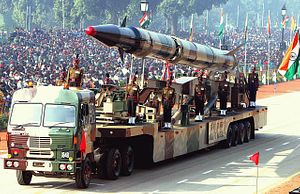India’s Strategic Forces Command (SFC) has recently test fired a medium to intermediate range nuclear capable ballistic missile as part of its annual training cycle to test the combat readiness of the Indian Army’s missile forces.
The Agni-II medium to intermediate range ballistic missile was launched from the Integrated Test Range (ITR) on Dr. Abdul Kalam Island in the Bay of Bengal off the coast of the Indian state of Odisha on February 20, according to defense sources speaking to local media.
The Agni-II missile was launched from a transporter erector launcher at 8:38 a.m. local time. It is unclear whether the test was successful or not. The last test of an Agni-II missile, which took place in May 2017, failed for unknown reasons, as my colleague Ankit Panda reported.
There has been an ongoing concern that the two-stage solid-fueled Agni-II—the purported backbone of India’s land-based nuclear deterrent—was inducted into service prematurely. Other tests, including a nighttime test of the missile in 2009, also ended in failure.
The missile’s maximum range is estimated somewhere between 2,000-3,000 kilometers and can carry a conventional or nuclear warhead of up 1,000 kilograms. The Agni-II was first deployed in 2004 and is both road and rail mobile.
It is part of the missile arsenal India maintains to uphold its nuclear warfighting doctrine of credible minimum deterrence. As I explained: “India has a No First-Use (NFU) policy and keeps its nuclear warheads de-mated from the actual missiles. India is estimated to possess 120-130 nuclear warheads.”
In January 2018, the SFC also tested India’s most advanced nuclear-capable intercontinental ballistic missile (ICBM), the Agni-V, as I reported:
The Agni-V, a three-stage solid fueled missile, has an approximate range of 5,500-5,800 kilometers [the exact range remains classified], and can carry a 1,500-kilogram (3,300-pound) nuclear warhead. India has reportedly also been working on multiple independently targetable reentry vehicles (MIRV) for the Agni-V in order to ensure a credible second-strike capability.
The Agni-V is designed to provide a credible nuclear deterrent against China.
In addition, The SFC has successfully tested a Prithvi-II tactical surface-to-surface short-range ballistic missile on February 9 and the test firing of an Agni-I short-range nuclear capable ballistic missile on February 6. Both test firing were classified as “complete successes,” which makes the absence of a corresponding statement regarding the February 20 Agni-II test even more conspicuous.
According to a February 20 media report: “The entire trajectory of the trial was tracked by a battery of sophisticated radars, telemetry observation stations, electro-optic instruments and two naval ships located near the impact point in the down range area of the Bay of Bengal.” The Indian MoD has so far neither confirmed that an Agni-II test has taken place.
(My colleagues Ankit Panda and Prashanth Parameswaran discussed recent developments with India’s nuclear forces in a podcast.)

































